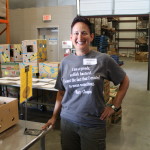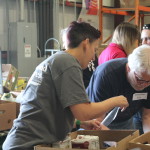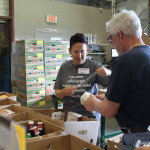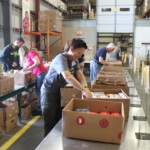We recently received a visit from Jess Kurti, who is volunteering at all 200 Feeding America member food banks. She’s also running marathons in each state, but we got her to pause for a second to tell us more about what she calls the Beast of Burden Challenge:
Jess, please tell us more about yourself.
Let’s start with: where are you from?
I currently reside in Kissimmee, Florida. Born in Chicago, raised in the suburbs of Chicago, attended college at the University of Miami, Florida. Biology/Criminology double major. I have lived in various parts of Florida ever since graduating.
Tell us about the Beast of Burden Challenge:
My goal is to raise awareness about the existence and importance of food banking in the fight to end hunger. I aim to highlight the wide array of programs food banks provide. And emphasize how easily any individual can get involved in ending hunger.
In addition, I would like to engage the running community about the importance of alleviating hunger. I’ve discovered that marathons and food banks have a surprising amount in common. No one knows the importance of nutrition for health, development, and performance more than a runner! (And a hunger fighter, of course.) As well as the absolute necessity of thousands of volunteers. No race would be remotely successful without the passion and dedication of so many volunteers. And operating a food bank would be next to impossible.
To this end, I will be volunteering at every food bank in the Feeding America network. All 200 of them! And running approximately one marathon per month as well. (I have one state remaining to have achieved running a marathon in all 50 states – Hawaii in September – but I will continue to run as long as I am able!).
When did you start this and when do you think you’ll finish?
Full effort began around September/October of 2014. I was running an insane amount of marathons (6 marathons and 1 half marathon in October alone), but a gradual shift in focus was occurring. Volunteering at the food banks became equally important, if not more so. I could visualize the end of the 50 state marathon goal and I began to wonder, then what? What was really important to me?
Even though I had previously volunteered at food banks in Colorado, New Hampshire, Idaho, Maine, and Oregon, I was still fairly singularly focused on running. I thought back to two of the many motivators for this quest: wanting a life of service over self (to be a part of something larger than me), and participating in a Virtual Town Hall held by Feeding America in July of 2014.
I also knew diabetes was prevalent amongst food insecure individuals. What I had never realized was how incredibly important diet is when managing diabetes. Knowing how much medication to take. The cost of an outpatient or inpatient trip to an ER. Even though my good friend and fellow marathoner Ed is diabetic, it never occurred to me how crucial just knowing where (and what) one’s next meal is coming from. That is when I fully realized how pervasive and insidious hunger is. That hunger effects all aspects of our lives. That if this fact was not active in my consciousness, how many others are unaware?
I anticipate finishing late 2016/early 2017. Food banks have the densest concentrations from the midwest to the east, which is closer to where I live. I’m attempting to finish the states farthest away first.
Logistically, how does your project work, i.e. how many food banks do you visit in a week, how do you get there, where do you stay, what do the food banks usually have you do while volunteering, etc.?
How many food banks I volunteer at in a week depends on the number in the area. I’ve been averaging four to five a week this segment which has included New York, Pennsylvania, Ohio, Vermont!, and now Minnesota, North and South Dakota. But that is too many. I feel I’m sacrificing quality for speed. So as I progress west, I’m making a lot more time for communication, social media, and writing, which I’ve neglected.
I drive most places; the majority of the time I car camp. I’m fortunate enough to have wonderful friends, family and the amazing running community along the way, so I do get an occasional break from the road. If the weather is really nasty, I’ll get a hotel room. And I will blissfully be flying to Alaska and Hawaii.
Tasks I’m assigned at the food banks are typically warehouse related: sorting and packing donations; bulk repack of produce and dry goods; meat sort and repack; salvage; assembling kids packs and senior boxes; picked orders; helped load orders into agency vehicles; stocked pantries and agency shopping areas. But I’ve also prepared hot meals for seniors, assembled boxes for Hurricane Sandy victims (families in New York and New Jersey still displaced years later…that was a shock), fortunately participated in offsite events with direct client contact including mobile pantries and produce distributions; assembled swag for giveaways at events, helped unload mail trucks for Stamp Out Hunger; collected food after trade food shows. I haven’t turned down an opportunity yet!
What have you learned about hunger in America?
That hunger has changed drastically.
Food banks (and by extension, the partner agencies) are no longer for the destitute. Or the last refuge in an emergency. Food banks are being forced to assist clients and families, many of them working poor, maintain the most basic level of security. Keeping families in their homes. Able to eat AND pay bills. Able to eat AND afford medication. Able to eat AND buy school supplies.
Maggie, at the Vermont Foodbank, asked me a great question. She asked if I thought food banks were the answer to ending hunger. My response was a resounding no. The competition for resources is already fierce in some areas. There needs to be serious action (read: legislation) in so many areas: jobs creation; living wage laws; laws decreasing food waste; streamlined access and distribution of food; free breakfast and lunch for school kids; and much more. Fortunately, I think these issues are gradually seeping more and more into the public’s consciousness.
What have you learned about food banking as a sector or industry?
My knowledge is weak in this area. I don’t get to experience enough of the business side to give a thorough answer. But I have observed this: Feeding America, federal, and state governments provide certain guidelines, but there isn’t one business model which fits every food bank. The factors which influence how a particular food bank serves its community are as varied as the food banks themselves: population density (urban vs. rural); amount of resources available from the community (monetary, goods/produce, as well as pool of volunteers); sharing of resources between food banks; geographical issues (bodies of water, mountains, sheer size of territory serviced, etc.); number and size of partner agencies; ability to adapt to changing technology; transportation costs; availability and quality of potential employees; respecting the laws of Native populations; attitude of general population in an area towards the hungry/food insecure.
Short version: I have a lot to learn.
What kind of food bank programs or features have you found interesting?
What I would call the “gap” programs are very interesting to me. A few food banks have started co-ops. These programs are available to everyone. Need/declaration is not required, nor is a commitment. For example, “Help Yourself Friday” at United Food Bank in Mesa, Arizona (download the PDF), and Food $en$e at the Food Bank of Central New York.
Food banks have incredible buying power; the more the food banks purchase, the more they can save and pass the savings on to the community.
Some of the tangential programs, which most people wouldn’t associate with hunger issues, are interesting as well.
The Food Bank of New York City has a permanent school supplies shopping area for teachers (schools need to demonstrate need).
Akron-Canton Regional Food Bank has the “Essentials Soap Room”, where they repack bulk donations of multi-purpose soap (safe for hair, skin, dishes, etc.) from GOJO. Since soap is crucial to safe food handling, general health, and disease prevention, I think that’s pretty cool.
How would you suggest people get involved with ending hunger in their communities?
Alleviating hunger could be achieved if a great many of us made small tweaks. A monumental effort is not required (although feel free to join me!).
A little research will uncover many opportunities. I recommend contacting your local food bank first. If volunteering directly at the food bank is impractical, there are still many options. Contact your local food bank to find out which of their partner agencies may be closest to you.
Not into traditional volunteering? Be sure to check out your local food bank’s special events listed on their website. You may discover your local food bank has a 5K run/walk, motorcycle ride, music fest, poker game, food drive, etc.; also some local businesses give a portion of their sales to your local food bank. There are also resources to hold your own funds or food drives.
Still don’t have the time?! Give money! Food banks regularly receive incredibly high ratings from charity watchdogs. Your donation will be guaranteed to go to those in need.
How can people find and support you (social media, website, taking action, etc.)?
Instagram: #beastofburdenchallenge #200foodbanks
I’m currently self-funding, but researching crowd-funding as well as becoming an independent 501(c)3.
Thank you, Jess, for sharing your story and perspective!
If you want to follow the Beast of Burden Challenge, we recommend following Jess on Facebook. And if you want to get more involved, visit the Vermont Foodbank website for more ways to help alleviate hunger in Vermont!




